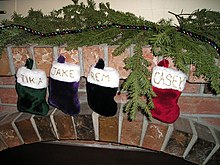Christmas stocking



A Christmas stocking is an empty sock or sock-shaped bag that is hung on Christmas Eve so that Santa Claus (or Father Christmas) can fill it with small toys, candy, fruit, coins or other small gifts when he arrives. These small items are often referred to as stocking stuffers or stocking fillers.[1] In some Christmas stories, the contents of the Christmas stocking are the only toys the child receives at Christmas from Santa Claus; in other stories (and in tradition), some presents are also wrapped up in wrapping paper and placed under the Christmas tree. Tradition in Western culture threatens that a child who behaves badly during the year will receive only a piece or pile of coal.[1] However, coal is rarely if ever left in a stocking, as it is considered cruel.[citation needed] Some people even put their Christmas stocking by their bedposts so Santa Claus can fill it by the bed while they sleep.
History
While there are no written records of the origin of the Christmas Stocking, there are popular legends that attempt to tell the history of this Christmas tradition. One such legend has several variations, but the following is a good example:
- Very long ago, there lived a poor man and his three very beautiful daughters. He had no money to get his daughters married, and he was worried what would happen to them after his death. Saint Nicholas was passing through when he heard the villagers talking about the girls. St. Nicholas wanted to help, but knew that the old man wouldn't accept charity. He decided to help in secret. After dark he threw three bags of gold through an open window, one landed in a stocking. When the girls and their father woke up the next morning they found the bags of gold and were, of course, overjoyed. The girls were able to get married and live happily ever after. Other versions of the story say that Saint Nicholas threw the three bags of gold directly into the stockings which were hung by the fireplace to dry.[2][3][4]
This led to the custom of children hanging stockings or putting out shoes, eagerly awaiting gifts from Saint Nicholas. Sometimes the story is told with gold balls instead of bags of gold. That is why three gold balls, sometimes represented as oranges, are one of the symbols for St. Nicholas. And so, St. Nicholas is a gift-giver. This is also the origin of three gold balls being used as a symbol for pawnbrokers.[2][3]
A tradition that began in a European country originally, children simply used one of their everyday socks, but eventually special Christmas stockings were created for this purpose. The Christmas stocking custom is derived from the Germanic/Scandinavian figure Odin. According to Phyllis Siefker, children would place their boots, filled with carrots, straw, or sugar, near the chimney for Odin's flying horse, Sleipnir, to eat. Odin would reward those children for their kindness by replacing Sleipnir's food with gifts or candy.[5] This practice, she claims, survived in Germany, Belgium and the Netherlands after the adoption of Christianity and became associated with Saint Nicholas as a result of the process of Christianization. Today, stores carry a large variety of styles and sizes of Christmas stockings, and Christmas stockings are also a popular homemade craft. This claim is disputed though as there are no records of stocking filling practices related to Odin until there is a merging of St. Nicholas with Odin. St. Nicholas had an earlier merging with the Grandmother cult in Bari, Italy where the grandmother would put gifts in stockings. This merged St. Nicholas would later travel north and merge with the Odin cults.[6]
Many families create their own Christmas stockings with each family member's name applied to the stocking so that Santa will know which stocking belongs to which family member.
The World's Biggest Christmas Stocking
This section may lend undue weight to certain ideas, incidents, or controversies. Please help to create a more balanced presentation. Discuss and resolve this issue before removing this message. (October 2014) |
According to the Guinness World Records, the largest recorded Christmas stocking measured 51 m 35 cm (168 ft 5.65 in) in length and 21 m 63 cm (70 ft 11.57 in) in width (heel to toe) and was produced by a volunteer emergency services organisation in Carrara, Tuscany, Italy, on 5 January 2011. To fulfill the Guinness guideline that the stocking contain presents, volunteers filled it with balloons containing sweets.[7]
Prior to this the record had been broken in London on 14 December 2007 by volunteers of The Children's Society, whose stocking measured 32.56m long and 14.97m wide.[8]
See also
References
- ^ a b Armah, Daniel A. (1 November 2011). "Lessons of Christmas". Xulon Press. p. 228. Retrieved 25 December 2017 – via Google Books.
- ^ a b Morris, Desmond (1992). Christmas Watching. Jonathan Cape. pp. 14–15. ISBN 0-224-03598-3.
- ^ a b Bowler, Gerry (2000). The World Encyclopedia of Christmas. Toronto: McClelland & Stewart. p. 156. ISBN 0-7710-1531-3.
- ^ "Three Impoverished Maidens". St. Nicholas Center. Retrieved 2013-11-17.
- ^ Siefker, Phyllis. Santa Claus, Last of the Wild Men: The Origins and Evolution of Saint Nicholas, Spanning 50,000 Years (chap. 9, esp. 171-173) (2006) ISBN 0-7864-2958-5
- ^ "Origin of Christmas | The history of Christmas and how it began". Simpletoremember.com. 1941-12-25. Retrieved 2013-12-27.
- ^ "Largest Christmas Stocking". Guinness World Records. Retrieved 14 May 2017.
- ^ "The World's Biggest Christmas Stocking". Childrenssociety.org.uk. 2007-12-18. Retrieved 2013-12-27.
- Guinness Book of World Records - Largest Christmas Stocking
- New York Times - The Christmas Stocking
- Holidays.net - The Legend of the Christmas Stocking
